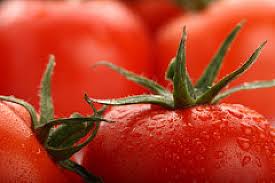There is no comparison between the intensely tart-sweet, juicy flavor of an in-season tomato and its bland, meek counterpart from the cold weather. A single ingredient can greatly improve even the best tomatoes. Salt is the key ingredient. It does more than season your food.
To be more precise, salting facilitates Osmosis. This is the process that, paraphrasing Kenji, draws liquids (in this case tomato juice) from an area with low-solute content (the inside of the tomato’s cell), through a membrane, and then into an area with high-solute concentrate (outside of the cells). Simply put, tomatoes will release their juices in a matter of minutes. This results in fruit that is less watery and has a stronger flavor.
But that’s not all. Salt stimulates salivary glands to produce saliva, distributing flavor to your tastebuds. Salt also reduces bitterness perception, which makes tomatoes taste sweeter.
These unique characteristics are what make us tomato-salting zealots. As with most zealots salting practices are governed by a few key principles:
1. You must drain tomatoes for tossing salads. If you have ever added tomatoes into a salad, you are probably familiar with the pool that forms at the bottom. This liquid is meant to soak up the leaves and reduce the dish’s flavor. What’s the answer? The answer is: This will intensify the flavor of the tomatoes and make sure that your dressing is the only liquid in the bowl. You can test it with this mixed herb salad or our modernized iceberg wedge dish.
2. Thou shalt not drain for-later tomatoes. This principle applies to any dish you prepare more than 15 min before serving.
3. You must not keep the juices. It can be used in your Bloody Mary or incorporated into a salad dressing (at your discretion, and not the tomatoes). Salting, draining, and recombining the juices with the tomatoes is essential in making our Andalusian Gazpacho. It also makes our Tomato Coulis faster and easier, and our Tuscan Panzanella.
4. Do not take out tomatoes ready to be used immediately. Take advantage of the tomatoes’ natural juiciness and season the tomato with salt at the end. This is a great way of enhancing BLTs, Caprese salads and Caprese sandwiches, as well as bruschetta and pan con tomato.
5. You must choose the right type and quantity of salt: We recommend using kosher salt if you are salting tomatoes to drain them. A heaping teaspoon should suffice for every pound. For tomato preparations that you will eat right away, make sure to grab the finishing salt. Flaky sea salt will bring out bright flavors and add a crunchy texture that table and kosher salts can’t match.
Salt is an integral part of the human diet. Salt is used to season food, preserve meat without refrigeration, and make soap and glass. Its limited availability and these characteristics made it an important commodity in the past. It was used as a form of salary in some cases.
Why is salt so important?
Salt is used to maintain a healthy balance of water and salt in the cells of our bodies. Salt in excess can cause cells to shrink due to water rushing out of cells from Osmosis. Osmosis is when too little salt is found in the blood. This causes cells to burst again from too much water. Salt is essential for nerves and muscles to function properly and regulate blood pressure. Our brains can’t function if we don’t have enough salt. Salt is essential for our survival. Salt is essential for organisms to survive.




